VANUA LEVU, FIJI — In 1643, the year after he “discovered” New Zealand and Tasmania, navigator Abel Tasman threaded his ship between the treacherous reefs surrounding this volcanic island. Tasman’s report on the passage was so daunting that his fellow navigators would avoid the area for another 150 years.
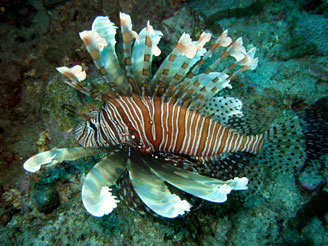
Four and a half centuries later, those very reefs are the great attraction of Vanua Levu — the 2nd-largest of Fiji’s 333-odd islands. The coral gardens serve as home and nursery to hundreds of species of fish, in every color of the rainbow: from red-striped lionfish to yellow Moorish idols; from orange clownfish indigo fairy basslets.
Four species of marine turtles are also found in Fijian waters, as well as many varieties of sharks, dolphins, and rays. To ice the cake, Fiji is known as the “soft coral capital of the world.” I was especially amazed by the “magic soft corals:” a mottled purple, they turn pure white when touched. The effect is a defense mechanism: when a triggerfish takes a nibble, the sudden, bleached appearance implies that the coral is dead, and inedible.
Like many islands with abundant reefs and sea life, Fiji’s coastal waters and forests are subject to increasing exploitation — not only by local villagers responding to population and market demands, but by outsiders as well. During the past seven years, Seacology has completed 18 projects in Fiji. All have involved the exchange of schools, civic buildings or goods in exchange for promises to conserve local reefs and forests. In June, a group of Seacology supporters traveled to Fiji to take part in the opening of two community centers: one in Viani, on the island of Vanua Levu, the other on neighboring Taveuni.
Though I’d written about Seacology projects in Indonesia and Vietnam, I had never been present at an actual ribbon-cutting ceremony. Fiji, with its long tradition of hospitality (to friends, at least) seemed the perfect place for the experience.
* * *
Nineteen years ago, visiting Fiji for the first time, I wrote that the islands looked like “Mother Earth in a moss teddy,” and they still do. There’s an undulating eroticism to this archipelago of islands and islets, lying 17 degrees below the equator and 1,700 miles northeast of Brisbane, Australia.
It takes a good hour to get to the village of Viani from Savusavu. The road begins as asphalt, but soon devolves into a packed dirt; soon after it’s a double-track, weaving through hillsides that look like they’re covered with green shag carpeting.
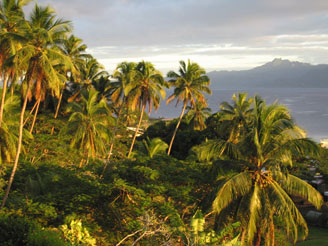
“We have a tradition of conservation in Fiji,” says Saula Vodonaivalu, Seacology’s country director and a native of the islands. He and his wife, Grace, have managed the 18 projects spearheaded by the foundation. I rode with them to Viani in a 4WD pick-up, bumping along the palm-fringed coast.
“When a chief died, the villagers would observe a tabu bogidau: 100 nights without fishing on the reef after the chief’s burial. Then, when the tabu (taboo) period ended, villagers wove nets out of coconuts leaves and set off to catch fish for a big feast. Even then, the nets were designed so that only the largest fish were caught; the smaller ones were left alone. So the idea of preserving is not a new thing in our country. The difference is that now, instead of 100 nights, we have an agreement for 10 years.”
The Viani project is what Seacology Executive Director Duane Silverstein calls a “win-win” relationship. Several years ago, Viani’s residents noticed an alarming decrease in the number of fish on their reef (and in their nets). The only solution in such a case is to leave the reef alone, and let it recover. Saula and Grace asked what the villagers wanted — what it would take — to compensate for the resources lost if they gave up fishing the nearby reefs (7,413 acres of them) and cutting the local jungles for a decade. What the village needed was a new community center. One year and $30,000 dollars later, the building is standing — and a group of 22 Seacology donors (including six children) are on their way to the opening ceremony.
“There’ll be traditional dancing,” Grace warns me. “I hope you are ready to dance.”
“No way.” I shake my head. “I have to preserve my journalistic integrity.”
“Forget it,” she laughs. “We get all kinds of people here. Doctors, lawyers, software engineers, all kinds. Everyone comes wearing a different hat. The villagers take off your hat, and hand it back to you when you leave.”
“That’s the way it is in these villages,” the stoic Saula agrees. “Everyone must participate…. Except for me.”
* * *
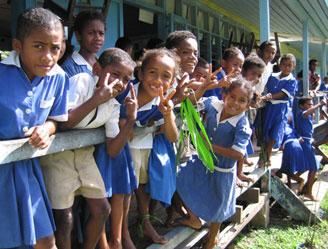
Before entering Viani, we stop at the village primary school to present three copies of a hardbound book about Fijian wildlife. We’re running late — even by Fijian standards — and the teacher seems miffed; he’s spent the morning trying to control a roomful of kids dressed in war paint. The books, translated into Fijian at great expense, are beautiful, but I don’t think the kids would have cared if we’d walked in with sacks of mismatched socks. They’re delighted to meet a delegation of aliens, and pose in shrieking masses for our cameras.
The children have songs to sing, and dances to perform, and they launch into their program with passion. I don’t think I’ve ever heard a group of kids sing in such perfect unison. Missionaries introduced choral singing to Fiji — long before the colonial period — and the tradition has blossomed amid these exquisitely expressive islanders.
And they all look about as happy as kids can be. That’s the other thing I remember about Fiji. Despite their reputation for ferocity, and a long tradition of eating their neighbors with sinister-looking forks, the Fijians are as welcoming a people as you’ll meet anywhere on Earth. No matter who you meet, or where you meet them, the national greeting — “Bula!” — is delivered with unimpeachable warmth. None of the half-muttered salutations of western city-dwellers darting past each other between Starbucks and the multiplex.
* * *
Viani is an unpresuming village of 250, a combination of tin roof shacks and coconut wood-framed homes surrounding a large, grassy square. The arriving guests walk in along a muddy beachfront — it’s been raining the past few days — to the porch of the new community center, where we sit on plastic chairs. A large group of women waits under a tin-roofed shelter to our right; a group of men in ceremonial leaf skirts sit beside pink-tufted battle spears in front of us. Once we’re settled in, the main “warrior” — a muscular and imposing Fijian sitting front and center — mixes a batch of turbid kava in a tanoa: a big wooden bowl standing on four legs.
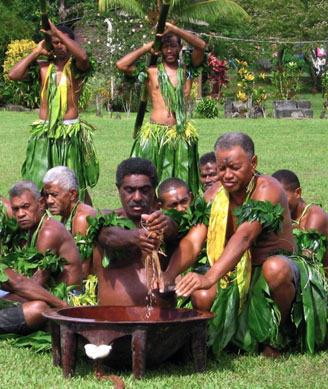
Kava is to Fijian social life as tea is to the British, combined with the ritual attention of Japan’s tea ceremony. It’s consumed at every social occasion, formal and informal, but no excuse is needed. A mild narcotic extracted from the roots of Piper methysticum (a cousin of black pepper), it is placed in a cloth ball and immersed in the filled tanoa. As the host squeezes and swirls the ball — imagine an oatmeal-filled sock — the kava infuses the water. Before long you have a bowl of what looks like dirty washing water, except you have to drink it. The infusion slightly numbs the lips and tongue, and tastes a bit chalky, but is not unpleasant.
(Kava became an international health fad in the late 1990s, and Fijian and Vanuatan farmers exported about $25 million of the herb each year. In 2001, a German study claimed that kava could cause liver damage; the market dried up overnight. The study has since been discredited, and kava exports may soon be on the upswing again — to the ire of locals, who will pay inflated prices for their “grog”.)
One by one, three representative men from our group are offered coconut-shell bowls of kava. One by one, they clap their hands together, cry “Bula!,” and drink up. As soon as they’re finished, everyone claps three times — and on to the next bowl.
I got high on kava in Fiji in 1988, during a short stopover en route to the Solomon Islands. My hosts were the family of the concierge at my small hotel in the capital, Nadi. We laughed so hard I rolled on the floor for half an hour. After the trip I bought some kava, and prepared it at home with a small group of friends. We drank cup after cup, even did the whole bula thing, but no one got off and I got a reputation for introducing drugs of dubious potency. Personally I think kava is a very entertaining high — but only in Fiji, and only under ideal circumstances, i.e., any circumstances involving Fijians. Otherwise, you might as well dip a ladle into your Maytag.
Once the kava is down, the celebration in Viani becomes rather abstract. There is an impassioned thank you speech, and the distribution of gifts (including a sperm whale’s tooth, one of the most prized ceremonial gifts in Fijian culture), but the entire exchange is carried out in Fijian. None of the guests understand a word of it, except for the frequent “Bula!”.
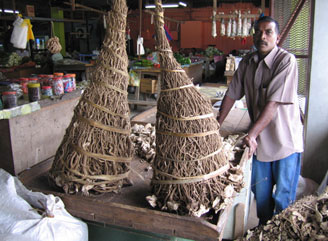
It’s soon time for the actual opening. Outside the community center is a small red curtain, and Seacology donor Anne Runolfsson (who, in a parallel universe, stars in The Phantom of the Opera on Broadway) parts the cloth to reveal a bronze plaque:
DONATED BY SEACOLOGY TO THE PEOPLE OF
VIANI VILLAGE
FOR THEIR GREAT SACRIFICE
IN PRESERVING THEIR FOREST AND MARINE LIFE
Frankly, I find the language a bit odd. To me, the phrase “great sacrifice” has dire connotations; as if the villagers gave up something forever, out of superstition or pure altruism. The Seacology contract derives from neither. When I press him, Saula agrees. Conserving the environment isn’t giving something up; “It’s like putting money in the bank” (with the new community center paid as advanced interest). It might be more attractive and appropriate, I think, to thank the villages for their “generosity and foresight”.
* * *
Ratu (Chief) Jope, 56, is a man of great presence and quiet dignity. He looks like a chief, and speaks like a chief: softly, but with absolute authority. He has close-cropped gray hair, and skin the color of burnished copper. He wears a brightly colored “bula” shirt, decorated with a floral print. To tell the truth he looks a bit like a Fijian Sean Connery (though you might not guess it from my picture).

The center itself is an airy, rectangular building; a single large room with louvered windows, yellow-painted cinderblock walls, and a floral linoleum floor. A cloth fringe hangs around the room’s edges, and the Seacology donors sit at one end of the building, in front of an enormous bouquet of wild ginger.
Jope’s thank-you speech is short and to the point. The community center, he says, is a dream come true. He thanks everyone involved — local allies as well as the Seacology donors. And then we eat: a lavish island banquet of locally caught and traditionally prepared wahu, lobster salad, roasted chicken, watermelon, papaya, and taro — Fiji’s answer to the potato.
After finishing my dessert (sponge cake, topped with pink frosting) I find Ratu Jope outside, arm’s length from a kava bowl. After introducing myself, I ask what uses he envisions for the center.
“My hope,” he says, “is to see the center used as a kindergarten and pre-school. For the larger community, I’d like to see the village develop a women’s handicraft center; a place where local women can weave their mats, for sale in town.”
In addition, of course, the center will be used for weddings, funerals, and other village occasions.
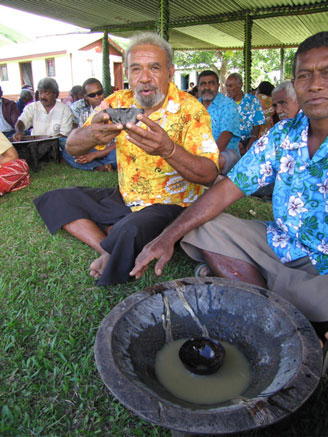
A trickier question about the no-take zone is the issue of enforcement. Anyone can declare a no-take zone — I could declare one at the lunch buffet — but who is going to listen, much less enforce it? Seacology is not providing money for patrol boats or wardens, so I’m concerned that the no-take commitment might be an agreement without teeth.
Not so, Jobe replies. Viani is not close enough to Suva to be an appropriate target for commercial fishing; the pressure comes mainly from the nearby settlements. As part of this program, Jope has held discussion with the Tikina Novatu — the committee of local villages — and received assurances that everyone in the area will honor the no-take zone. (The indigenous people of Fiji, incidentally, retain ownership of 83% of their country.)
There’s another element to the equation as well. Fijian society is divided into two arms. There’s the actual Government of Fiji; then there’s the Fijian Affairs Provisional Council, steered by the Great Council of Chiefs — a body, which, as Saula puts it, “takes care of the Fijian way of doing things.”
It is written into Fijian law that, when villages enter into contracts, the federal government must honor the conditions of those contracts. So, by virtue of their agreement with Seacology, the preservation of Viani’s reefs and forests must be respected by the government. Those who violate the local contract, in other words, can be prosecuted at the national level.
This also means that the villages themselves can enforce their no-take zones, and confiscate materials used by poachers. This occurred in 2004 on the nearby Namena reef, Fiji’s only true national marine reserve. Furious villages — using a patrol boat donated by Seacology — caught two fishing boats, and confiscated their outboard motors. The motors were sold — and the proceeds used to fund a coral reef education program.
* * *
As Jope and I finish speaking, the local women have started dancing, pulling the men from the Seacology camp into their bunny hop with shrieks of glee. I leave my “hat” by the tanoa and join them. As we stumble in line across the grass, clutching at each others’ waists, I’m pinged by a cosmic truth: if saving the world is ever going to catch on, it had better be at least as much fun as the alternative.
Read Ethical Traveler's Reprint Policy.
